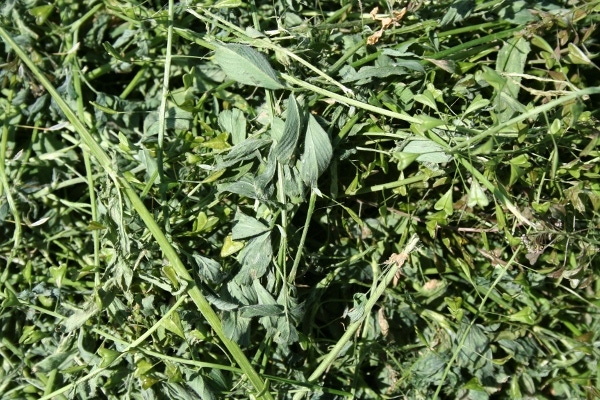August 23, 2017

(Written by Mike Ottman and Ayman Mostafa, University of Arizona)
Phosphorus is the primary mineral nutrient likely required by an alfalfa crop in Arizona. A single application of phosphorus fertilizer at planting time may be sufficient for the life of the stand in certain situations.
However, on soils with a high phosphorus fixing capacity, a single application of phosphorus fertilizer at planting time may not be sufficient. On these soils, phosphorus fertilizer may be necessary on an annual basis, or even several times each growing season.
The availability of phosphorus fertilizer in certain soils decreases over time to such an extent the soil may be deficient in phosphorus a few months after fertilizer application, thus warranting multiple applications in a season.
Phosphorus deficiency in alfalfa is characterized by reduced plant height and leaf size. The leaflets may tilt upwards. The crop may also have a dark blue-green appearance. Alfalfa usually does not exhibit purpling of the leaves as occurs with phosphorus deficiency in other crops.
Phosphorus deficiency in alfalfa is difficult to detect since the reduction in growth is not apparent unless the crop is compared to alfalfa with adequate phosphorus.
Phosphorus can be supplied to alfalfa on soils with a high phosphorus fixing capacity in several ways:
1 – By applying high rates of fertilizer;
2 - Using multiple applications of fertilizer;
3 - Banding the fertilizer;
4 - Applying manure as a phosphorus source;
5 – Using sources of phosphorus fertilizer that are complexed with humic, fulvic, or other organic acids; and
6 - Lowering the soil pH.
Applying high rates of phosphorus fertilizer may be inefficient since phosphorus fertilizer can be rapidly fixed by the soil, but there will be a brief time of high phosphorus availability after the application.
Multiple applications of phosphorus fertilizer, such as every few months, may be needed each season, particularly in the spring, to maintain soil test levels in the adequate zone.
Banding fertilizer is not a common practice in alfalfa, but applying a liquid formulation in a narrow band on top of the soil may be a way to reduce phosphorus fertilizer fixation by limiting the amount of soil the fertilizer contacts.
The phosphorus in manure is tied up in organic compounds and does not have as much chance to become unavailable in the soil as inorganic fertilizer.
Several fertilizer products are on the market in which the phosphorus is complexed with various organic acids, making the phosphorus less likely to be fixed in the soil, similar to manure. Lowering the soil pH can make soil phosphorus more available, particularly on soils with a pH between 8.0 and 8.5.
Currently, UA does not have strong research data to show differences among fertilizers for supplying phosphorus to alfalfa. Therefore, the UA’s recommendation is to apply phosphorus fertilizer based on cost per pound of phosphorus or based on the convenience of applying fertilizer in irrigation water in the case of liquid fertilizers.
About the Author(s)
You May Also Like




